Rich and creamy, smooth and tangy is the name of the game with this no-bake passionfruit cheesecake. It’s easy to make, sets to the perfect set-yet-creamy consistency and you can make it ahead of time.
Love a cheesecake? Definitely try this no bake strawberry cheesecake and no bake raspberry cheesecake.
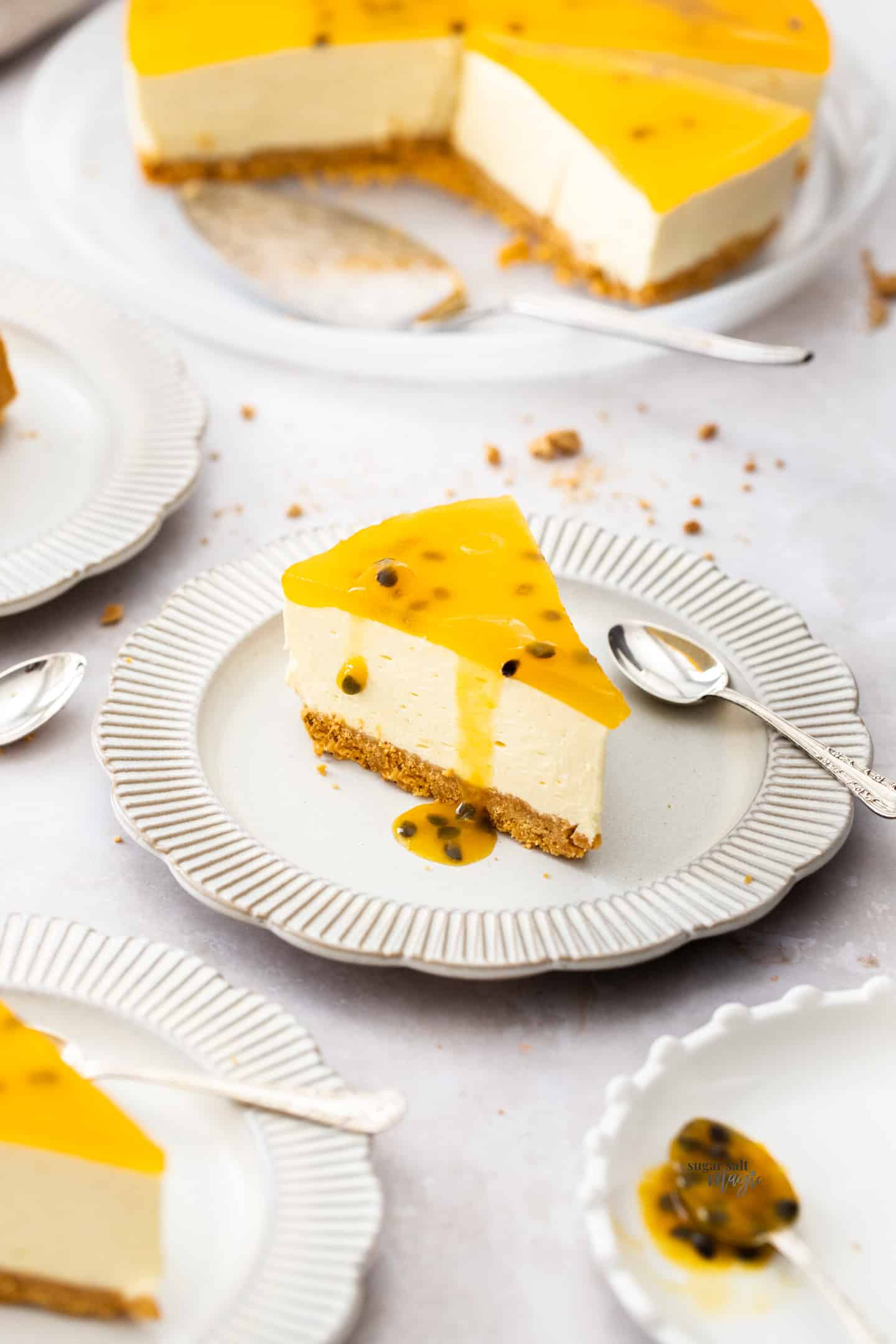
Why you’ll love it
If you’re a cheesecake lover, then you’re going to love the richness yet perfect tartness of this no bake passionfruit cheesecake.
- Buttery, no-bake cookie base.
- Creamy, lightly passionfruit flavoured cheesecake filling.
- A simple tart, passionfruit jelly topping.
The passionfruit jelly topping adds the perfect tartness to this cheesecake. If you’re like me and love the flavour of cheesecake but can’t eat a lot of it, this is the one for you. The tartness of the jelly balances out that ultra-rich filling.
If you don’t like jelly, just use some passionfruit curd instead (link just above the recipe card) or spoon over some passionfruit pulp at the end.
This passionfruit cheesecake is so simple and just so so delicious. This passionfruit panna cotta is the same kind of simple, no bake, delicious tropical treat.
Tools you’ll need
- An 8 inch round springform pan
- An electric handheld beater or stand mixer
- Small saucepan
- Mixing bowls and silicone spatulas
Ingredients for passionfruit cheesecake
How can you go wrong with a rich cheesecake that only needs 7 ingredients? It keeps this recipe stunning but simple.
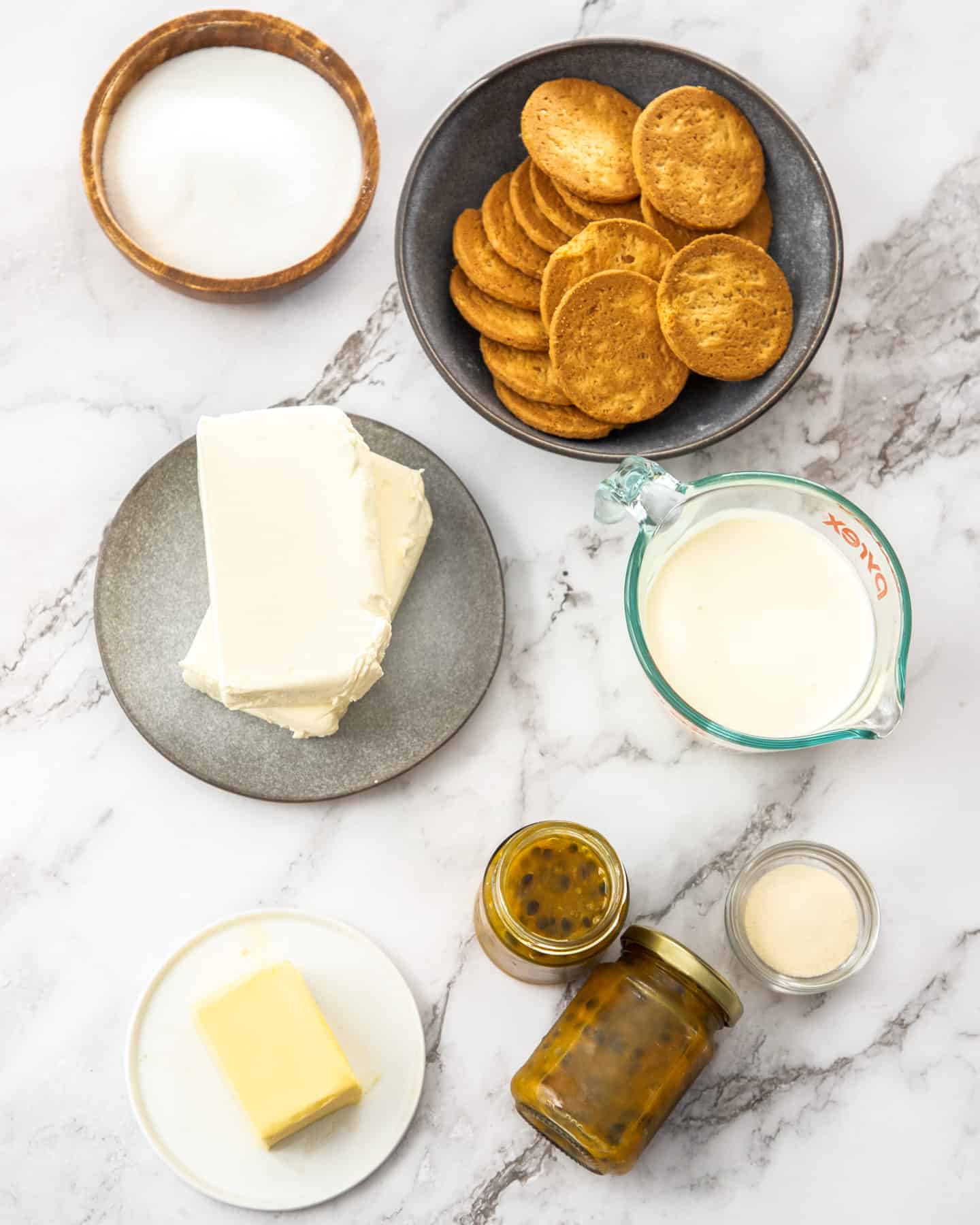
Detailed quantities and instructions in the recipe card below.
- Cream cheese: Use full-fat cream cheese. Light cream cheese won’t set so well.
- Powdered gelatine: I use powdered gelatine for this cheesecake as I personally find it easiest to use. Gelatine sheets all have different strengths so I cannot say which or how many to use.
- Biscuits / cookies: I use Arnotts Granita (digestive) biscuits for the base but there are many you can use. Arnotts Malt-o-milk also work well and so do Graham Crackers.
- Butter: Use unsalted butter for the base as you don’t want a salty flavour that salted butter can give.
- Sugar: I use caster sugar (superfine sugar) so that it mixes through and dissolves into the cream cheese mixture perfectly without any graininess leftover.
- Cream: Heavy cream, thickened cream, whipping cream – these will all work. You want a cream with 35% fat content so that it whips properly. Light creams won’t work.
- Passionfruit pulp: You can use fresh passionfruit pulp, jarred fresh pulp or even passion fruit pulp in syrup that comes in tins. The tinned form tends to be sweeter than the other two. You can also use frozen passionfruit pulp, thawed. Leave the seeds in if you like or remove them, like I have.
Being no bake, there are no eggs in this cheesecake.
This cheesecake can easily be made gluten-free – just substitute the regular biscuits / cookies for gluten-free cookies.
How to make a no bake cheesecake
Where I’m from, baked cheesecakes aren’t really a big thing and they’re more often than not, no bake. There are a few ways to set a no bake cheesecake. I love using white chocolate sometimes which makes for a lighter set and luscious cheesecake.
This passionfruit cheesecake recipe uses gelatine to set it but it’s still soft and perfect – don’t worry, it’s not firm like jelly. Using gelatine is a balancing act to get a texture that has a nice mouthfeel yet still firm enough to hold it’s shape. Luckily, I’ve done all the testing for you.
While there are 3 layers to this, each one is simple and this no bake passionfruit cheesecake is incredibly easy to make.
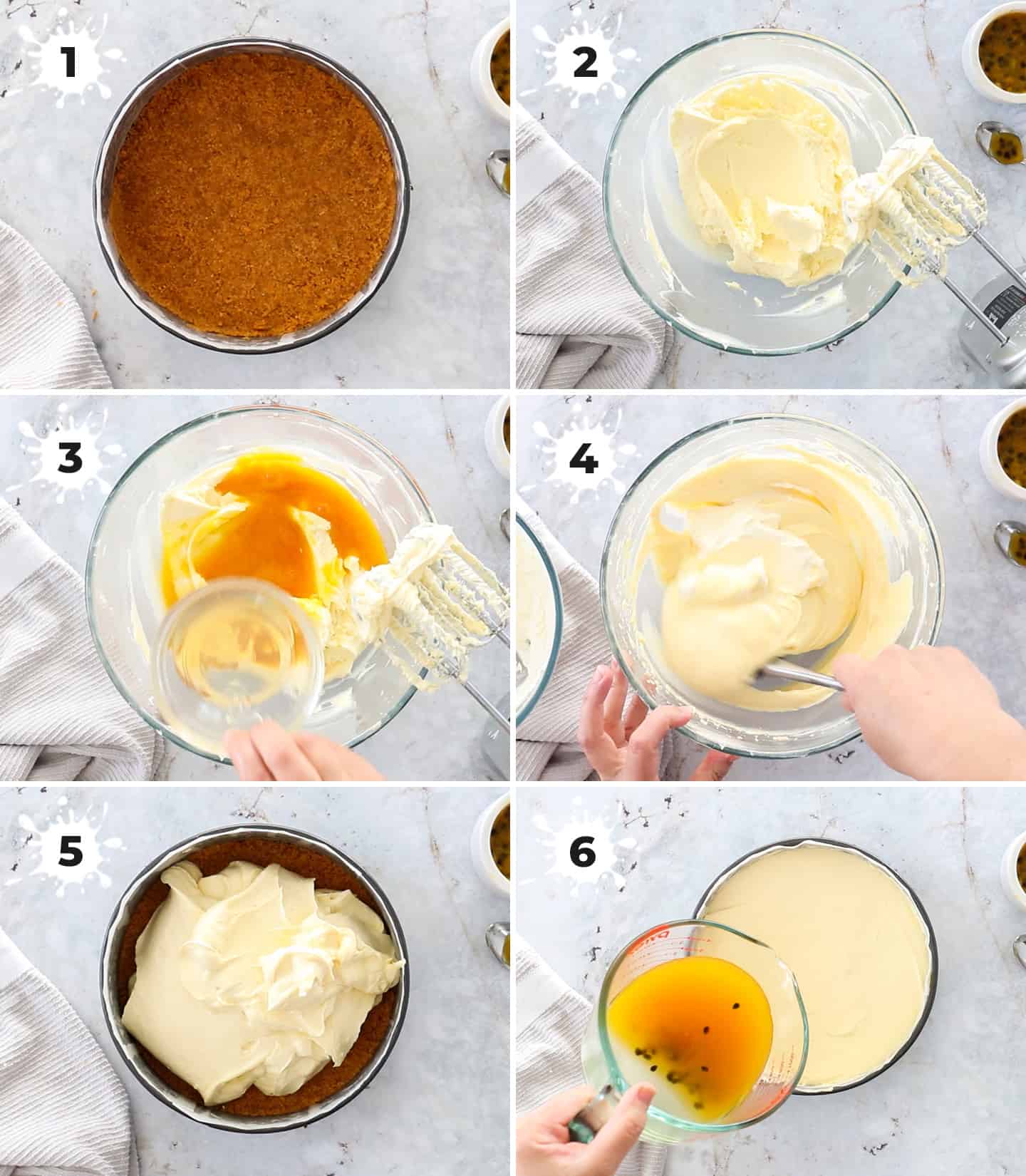
Detailed instructions in the recipe card below.
- Prepare your tin: Place baking paper over the base of of an 8 inch spring form tin, then add the outer ring and clip it into place. Now use scissors to trim off the overhang. Next, grease the sides with butter, then line with strips of baking paper.
- Make the biscuit base: Blitz the biscuits /cookies in a blender or food processor to crumbs (or you can use a rolling pin and bash them in a plastic ziplock bag). Mix them with melted butter and tip them into the tin. Press down all over with the bottom of a glass to create a flat base (photo 1).
- Make the cheesecake filling: Whip the cream to soft peaks in a medium bowl, using a handheld electric beater or balloon whisk and place in the fridge. Dissolve the gelatine in boiling water and set aside. Beat together the cream cheese and sugar (photo 2), then add the passionfruit pulp and gelatine (photo 3). Now, carefully fold in the whipped cream (photo 4). Tip the mixture into the tin (photo 2) and spread over the base giving it a level top.
- The jelly topping: Soften gelatine in some water in a saucepan, then heat over very low heat, stirring until it’s dissolved. Add the sugar and dissolve that in too. Now add the passionfruit pulp. Let it chill to at least room temperature before pouring onto the cheesecake layer (photo 6).
Now all that’s left to do is chill the cheesecake and wait for it to set – at least 6 hours or overnight.
This chilling time is the very thing that makes this a wonderful make-ahead dessert.
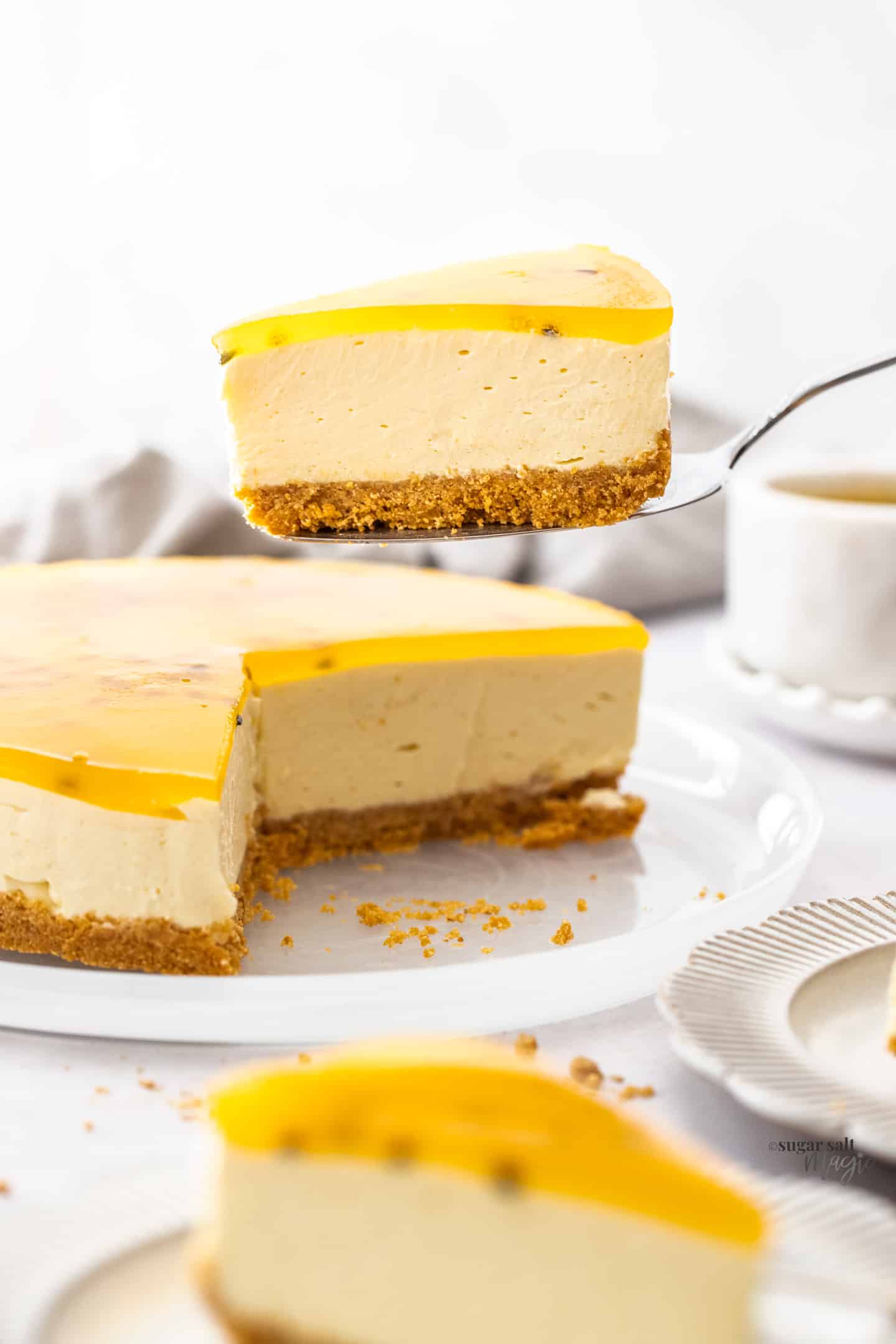
Tips and tricks
- Make sure the cream cheese is properly softened: If it’s still cold, you’ll end up with lumps in your cheesecake. To get a perfectly smooth cheesecake, let it come to room temp first.
- Make sure all the gelatine is dissolved: If you see any lumps of gelatine that aren’t dissolved they will remain firm lumps of gelatine in the cheesecake so make sure it’s all dissolved. If it’s not mixing in, you can heat it in the microwave for 10 seconds and give it another stir and it should dissolve fine.
- Don’t boil the gelatine: When you have the gelatine and water in the saucepan, you don’t want to bring it to a boil. Heat it over very low heat so there is just enough heat for it to gradually dissolve.
- Make sure the gelatine mix is runny before adding it. If it cools too much, it will start setting and you’ll end up with lumps in your cheesecake.
Variations
I love that this recipe can be altered to suit other flavours too. Use some strawberry sauce and top it with a strawberry jelly or top this one with my passionfruit curd.
How to store it
Store your passionfruit cheesecake in the fridge, in an airtight container for 3-4 days. No bake cheesecakes don’t tend to freeze well as the texture will change on thawing.
Passionfruit cheesecake FAQ’s
This one, yes you do. Not all cakes use gelatine though. For instance, this Tim Tam cheesecake uses chocolate or this easy baked cheesecake is set by baking with eggs.
You sure can. Try making it with lemon juice in place of the passionfruit (cut down to ⅓ cup) and use a homemade lemon curd on top. Want to get really creative? Try using this raspberry sauce (strain out the seeds) in place of all the passionfruit.
This recipe is quite versatile. You can use fresh passionfruit and scoop the pulp out yourself or use the type you get in jars or cans. You can also use frozen passionfruit pulp, thawed.
It’s possible but, as I don’t use them, I could not tell you how much or which grade you’d need. You may need to do some research first to determine the right quantity.
As above, it is possible, however as I don’t use it, I can’t give you the correct ratios. Agar will also give a slightly different texture.
This recipe is really easy to halve. Make it smaller by halving everything and setting it in a loaf tin instead. Make sure to line the tin in a way that you can lift the cheesecake out once set.
You can make this cheesecake gluten free by simply swapping the biscuits / cookies with a GF version.
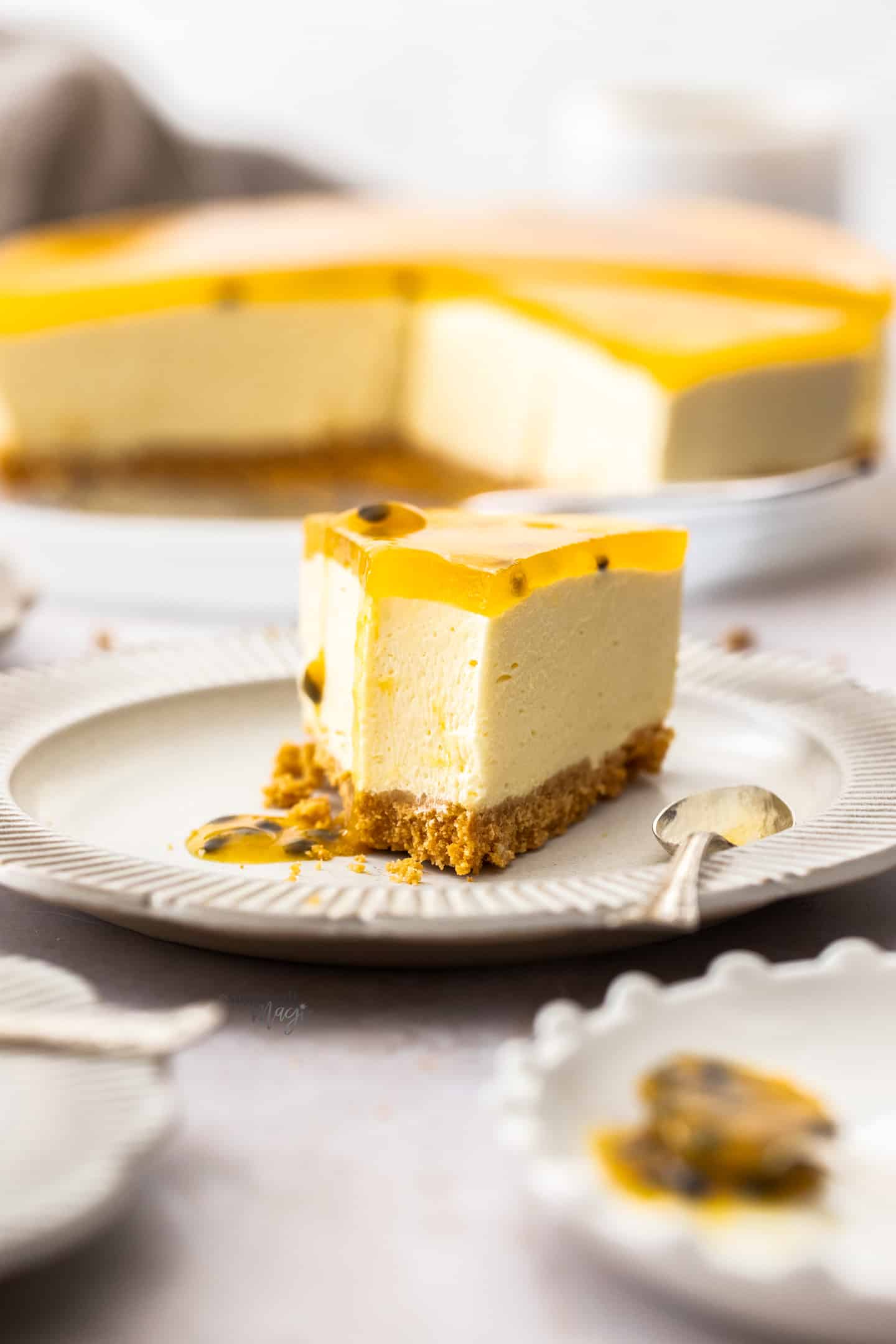
If you try this passionfruit cheesecake recipe, please take a moment to leave a rating and comment below. I love hearing from you and it helps other readers too! You can also take a photo and tag @sugarsaltmagic on Instagram.
More recipes you’ll love
- Passion Fruit Ice Cream
- Passionfruit sponge cake
- Homemade Passionfruit Curd
- Passionfruit Slice
- Mango Coconut Cheesecake
- No Bake Lemon Meringue Cheesecake
- No Bake Blueberry Cheesecake Parfait
- No Bake Chocolate Peanut Butter Cheesecake
Never Miss a Recipe!
Get the latest recipes straight to your inbox!
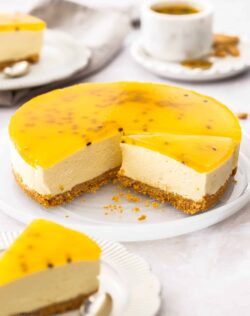
Video
Ingredients
FOR THE BASE
- 200 g digestive biscuits (7oz) (notes 2)
- 85 g unsalted butter, melted (3oz / ¾ stick)
FOR THE FILLING
- 2 teaspoons powdered gelatine
- 1 cup whipping cream (250ml)
- ½ cup strained passionfruit pulp (125ml)
- 500 g cream cheese, softened (1.1 pounds)
- ⅔ cup caster (superfine) sugar (140g / 4.9oz)
FOR THE PASSIONFRUIT JELLY
- ½ cup water (125ml)
- 1 teaspoon powdered gelatine
- ¼ cup caster (superfine) sugar (or granulated) (50g / 1.8oz)
- ½ cup strained passionfruit pulp (seeds set aside) (125ml)
For best results, always weigh ingredients where a weight is provided
Equipment
- An 8 inch round springform pan
- Small saucepan
Instructions
FOR THE CHEESECAKE
- Grease then line the base and sides of an 8 inch spring form tin with baking paper.
- Blitz the biscuits / cookies in a blender to crumbs. Add the melted butter and mix well. Tip the crumbs into the baking tin and use a glass to press down firmly all over the base.
- Mix the 2 teaspoons of powdered gelatine into 1 ½ tablespoons boiling water until no lumps remain (notes 3 & 4).
- In a medium bowl, beat the cream using a handheld electric beater or balloon whisk to soft peaks and place in the fridge.
- Using a handheld electric beater, in a large bowl beat together the cream cheese and sugar until smooth. Scrape down the sides and beat a touch more if you still see lumps.
- Add the passionfruit pulp and gelatine mixture and beat well to combine.
- Gently fold the cream, one third at a time, into the cream cheese mixture, taking care not to knock all the air out.
- Pour it over the base and spread it out, levelling the top so that it's flat. Make sure it's pushed right up against the sides all the way round – this will stop the jelly from seeping down the sides when you add it.
- Chill while you make the topping.
FOR THE PASSIONFRUIT JELLY
- Place the water (½ cup) in a small saucepan and sprinkle the gelatine over the top. Let it soften for 2 minutes, then place it over very low heat, stirring constantly until the gelatine has dissolved (don't allow it to bubble).
- Add the sugar and stir, again over low heat, until dissolved and you have a clear syrup.
- Remove from the heat and stir in the passionfruit pulp and 2-3 teaspoons of the reserved seeds (or more to your taste).
- Chill the jelly for 10 minutes or until at least room temperature. Place the cheesecake, still in the baking tin, on a plate (this will catch any liquid if it escapes down the sides). Carefully pour over the passionfruit jelly and return to the fridge to chill for 4-6 hours, or overnight.
- To remove the cheesecake from the tin, use an offset spatula or knife to gently ease the paper from the sides of the pan, all the way round. Now release the spring clip and lift the outer ring off. Peel away the paper from the edges. Now, using the very edges of the paper under the cheesecake, lift all the way round to release it from the pan base. Now slide a large flat spatula or similar between the paper and cheesecake base and release it all the way across. Now simply slide the cheesecake off the paper onto your serving plate.
Notes
- For best results you should always weigh ingredients like flour and sugar. Kitchen scales like these are relatively cheap but if you can’t weigh the ingredients, use the spoon and level method (don’t scoop).
- Cookies / Biscuits: I use digestive biscuits (specifically Arnotts Granita) which is a whole meal cookie popular in Australia and UK. Graham crackers will work fine but other types of biscuits work too – as long as they’re crunchy. For a GF cheesecake, use GF cookies.
- If you find your gelatine not fully dissolving, press the larger lumps up against the sides of the bowl to spread and melt them or heat in the microwave for 10 seconds and give it another stir. If you don’t fully dissolve the gelatine, you’ll get small bits of firm gelatine in the cheesecake.
- Make sure the gelatine mix is runny before adding it. If it cools too much, it will start setting and you’ll end up with lumps in your cheesecake.
This post may contain affiliate links that earn me a small commission for my referral, at no extra cost to you. Thank you for supporting Sugar Salt Magic.

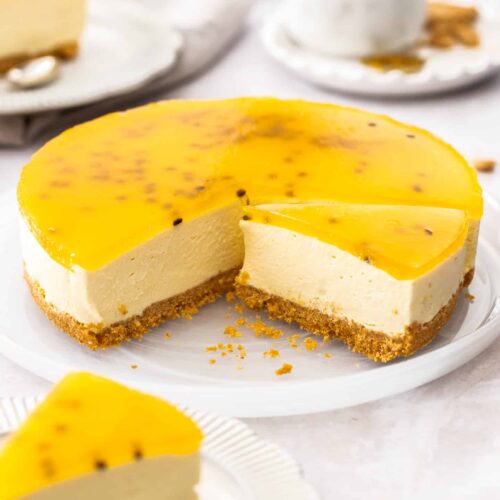


63 Comments on “No Bake Passionfruit Cheesecake”
I followed the instructions and got a good result
So happy you enjoyed it, Stephen. Thanks so much for dropping back to leave a review.
Hello
Thank you so much for your recipe!
I made the passion fruit cheese cake using the agar agar for the jelly and it worked out great! The cheese cake is so light and tangy, one portion is just not enough
So happy you love it, Hasmita. Thanks so much for dropping back to leave a review.
I’m a novice male cook but found this delicious and easy to make. I also froze half of it for 6 months and it still tasted great. Next I’m trying the mango one.
5 out of five from me.
Thanks for supplying such an easy to follow recipe.
I’m so happy you love it, Paul 🙂
BTW Marie, I used passionfruit from my vine. Didn’t remove seeds just put the whole lot in, fantastic. Thanks again.
Paul
What a treat, straight from the vine 🙂
Third time making this cheesecake!! Delicious and light, although I’ve had trouble getting the passion fruit jelly to set, so, on this my 3rd attempt I increased the gelatine to 2 1/2 tsp, it set up beautifully, so happy to give this recipe a 5 star rating!!!
Hi Wendylou. I’m so happy you love it. The jelly issue is a strange one. The amount as written definitely works for me so it could come down to a few things. Maybe different brands of gelatine have different setting strengths though the pack I buy doesn’t state a strength on it. The other things that can affect gelatine setting is making it too hot. If it starts to bubble, it will ruin the efficacy of the gelatine. Also, you need to keep a really close eye on making sure all the gelatine granules are definitely fully dissolved and there isn’t any little clear bubbles of it left. This is easiest to see using a rubber spatula.
🙂
Hi! Do you know if i can just omit the gelatine?
No, you can’t. It needs the gelatine to set.
Do you know if this would work with a vegetarian equivalent to the gelatine powder (e.g. Vege-gel or agar agar powder)?
I’m sorry, I don’t. Anyone else here know how these would go?
I made this cheesecake with home grown passionfruit, and I’m not a cheesecake person, but this was the best dessert I’ve ever made, my guests keep asking when I’m making it again…
This makes my day to hear, Gail. I’m so happy you all love it.
Made this cheesecake some time ago for a family birthday and it was absolutely delicious. Managed to buy frozen passionfruit pulp withou any added sugars, so it saved me from having to buy tons of the fruit itself, depulping and deseeding it. What remained was put in an ice tray and used for passion fruit gin&tonics. I was thinking of making it again but with lime, could that be made the same way as you mention with lemon in the tips?
Thank you so much for this amazing recipe 🙂
Hello Suzanne. Yes you can. With both the lemon or lime juice it will be a softer cheesecake but will still be set and able to be sliced. Enjoy 🙂
Have tried many a cheesecake recipe and this one is perfection. I am either hounded for the recipe or requests to make it again! Thanks so much 🙏
So happy to hear this, Ash. Truly appreciate you dropping back to leave a review 🙂
Hi there, If i want to make a large cake, can i simply double the recipe and do everything the same? Maybe a bit longer in the fridge?
And assuming i would need a 16inch cake pan right??
Thank you!
I am so excited to make this tomorrow!
Hi Lauren. Two batches of the filling would be tricky to work with all in one, unless you have a very big mixer so it might be best to mix the two batches separately. You’ll have to be extra careful that the gelatine is mixed through properly and even then I haven’t tested this in such a big pan so I’m not sure if it would have any stability issues. I’d love to hear how it goes if you try it.
Hey, thanks for your quick response!
Could I add additional of anything to help with the stability?
Also, I could definitely mix them separately and then just put together in the pan?
I was just hoping to make enough for 20 people (ish) ☺️
Or better to maybe just make two separate cakes?
Hi Lauren. There’s no easy way to know without testing it. It may set up just fine but I find not all recipes work simply by doubling the recipe. I think it’d be safer to make the two cakes.
Hi Marie, Thank you for your help!!
I ended up making 1.5x the recipe and used a 9.5 inch pan
It turned out PERFECT, was the best passionfruit cheesecake ever and everyone absolutely loved it!
Only thing we messed up was that after dinner we left the cake out of the fridge for a little bit and the jelly melted, BUT, the cake was still delicious the next day and still managed to get it in the frige while there was still some jelly on top ;D
Thanks again, have followed you on Instagram and will definitely check in next time im making a cake! Have already spotted another cheesecake you’ve got.
So happy to hear this, Lauren and thanks for your tips to scale it up. The good thing about the jelly is, if it melts, it’s just sauce and it can set wherever it likes, it still tastes amazing 🙂
Amazing!
Really delicious 😋 I also put some of the seeds into the filling too for some extra crunch. Family really really loved this cheese cake too !
Highly recommended 😊
I’m so happy you all love it, Ella. Thanks so much for trying my recipe 🙂
Another fantastic recipe Marie! Thank you so much for the detailed step by step instructions and for your hard work to develop, photograph and share this delicious passion fruit cheesecake! Your website is a treasure trove 🙂
Such kind words. Thank you so much for your support and I’m so happy you love it 🙂
Hi! If using curd, do I need to wait for it to cool completely before pouring over the top? Thanks!
Hi Lucy. Yes, best to let it cool at least to room temperature.
Hello! I am excited to try this cheesecake to serve to some family coming over this weekend (and will definitely leave a review after I do!)
I am a baker who is getting married in a few months and we are having no-bake cheesecake at the wedding. I’m trying to determine if I can handle making 6-8 of these to save some cash, and freezing them for a few days before the wedding. I have the freezer space. I’ve read up on the proper ways to freeze and de-thaw a no-bake cheesecake, but not sure if I’m convinced the gelatine will respond well to freezing. Has anyone tried freezing this cheesecake (without the jelly on top, would add that after de-thaw and before serving), or do you think it could work? Thank you for the input!!
Hi Alilbaker and congrats on your upcoming wedding 🙂 I don’t suggest freezing this cheesecake. Gelatine does not generally survive freezing and the texture may end up being a little grainy. Do you have time to test one – make and freeze for a couple of weeks and see how it goes? Other than that, I’d suggest either a baked cheesecake or a cheesecake set with white chocolate. Another option is to make individual cheesecakes and maybe layer them up on a tiered stand.
Amazing!! First time I’ve made a cheesecake and this recipe was outstanding. The hints were super helpful as id never baked with gelatine before.
I’ve tried many passionfruit cheesecakes, both store bought and home made and I can honestly say this was the most delicious.
Thank you, I’ll be making this again for sure.
You made my day 🙂 So happy you love it, Jax. Thanks so much for leaving a review
Hi was wanting to make this later this week, what is the fat content of whipibg cream? I can’t seem to find it where I live and was trying to find another cream with a similar fat content 🙂
Hello Annika. You’re looking for a cream with at least 36% milk fat.
This is delicious. I swapped out half of the passionfruit pulp for mango pulp in the cream mixture and the jelly as an alternative. Saved for future no-baking!
So happy you love it, Martin and great swap!
I did this for a catering job on the week nd and it was delicious
So happy you loved it, Helen 🙂
Made this today and it was amazing! Everyone loved it
I’m so happy everyone loved it, Ms Able. Thanks so much for making my recipe 🙂
I love this cheesecake! Great summer recipe, passion fruit gives great flavor. Even someone who doesn’t love cheesecake enjoyed this one. Thanks for sharing ❤️
So happy you love it, Malgorzata. Thanks so much for making my recipe 🙂
Very beautiful and people have told me it was the best cheesecake they have ever eaten ….a bit fidly but well worth the efford.
I’m so happy to hear this, Julie. I truly appreciate you trying my recipe.
Gelatine topping did not set and was in the fridge overnight . recipe says 1 teaspoon but in the video looks like a lot more.
Hi Shaz. There is definitely just 1 teaspoon of gelatine required in the jelly. Are you positive that all the gelatine dissolved and there were no lumps of it left? Having lumps will mean it’s not distributed through the mixture and the mixture won’t set. Did your jelly mixture come to a bubble – that will lower the efficacy of the gelatine?
Hi! Made the passion fruit cheese cake. Simply delicious. Thanks.
So happy you love it, Misriya. Thanks for making my recipe 🙂
Hi, what kind of sugar did you use in the jelly please was it caster or icing? Thanks!
Hi Kirsty. It’s just caster or granulated sugar.
Delicious!!! My husband and I already had 2 slices each. We love it!!
So happy you love it, Lize. Thanks so much for trying my recipe 🙂
Tried but all the jelly on top ran out the bottom :(. Any suggestions?
Hi Vicky. It just sounds like there were gaps at the edges – since the jelly is liquid when you pour it on, if it finds a gap, it will leak through there. Just make sure the filling is pushed right up against the edges. I’ll make notes in the recipe about it too. Thanks for your feedback.
This recipe is so easy and I love the creamy texture and passion fruit jelly top. I have pinned it as a favourite for use again. Thank you so much for the notes especially with regards to the gelatine hints. I have shared the recipe with my family and friends.
So happy you love it Monique. Thanks so much for trying my recipe.
Yum….and easy. Thank you Marie.
Thank you so much, Pamela.